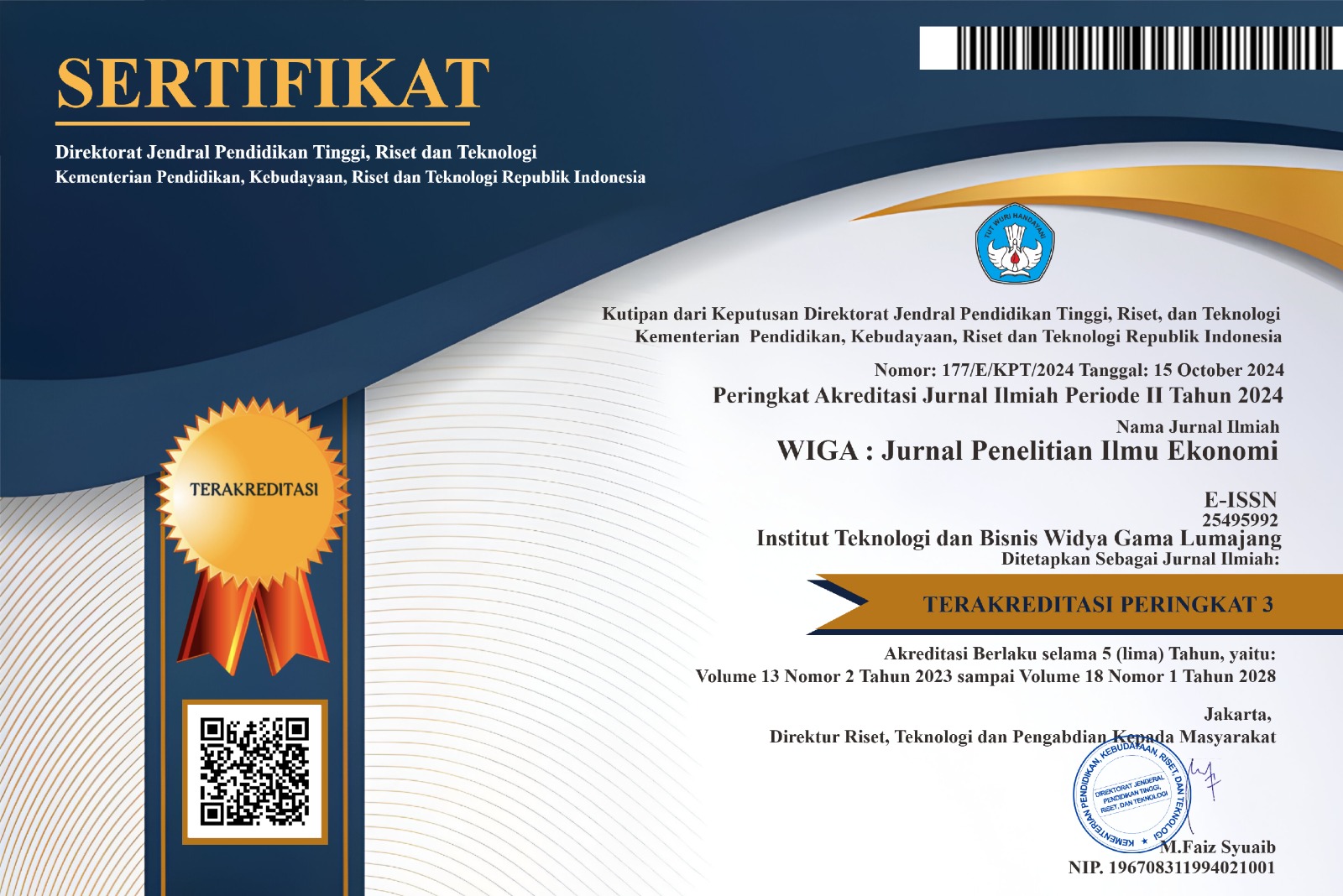Explaining Cyberloafing Behavior: The Role of General Strain Theory
DOI:
https://doi.org/10.30741/wiga.v10i2.596Keywords:
General Strain Theory, Cyberloafing Behavior, Job Stress, Perceived Organization SupportAbstract
The internet has changed the way employees get things done. However, many have not been on target regarding the use of the internet among employees. The availability of internet facilities in many organizations is used for personal gain or what is often referred to as cyberloafing behavior. General strain theory in this research is used to explain cyberloafing behavior. This behavior is not a criminal act but violates organizational regulations caused by organizational support and employee work stress. This study aims to assess the role of organizational support and reduce employee stress levels and cyberloafing behavior. The method used is in the form of PLS by involving 330 government employees in Lumajang Regency as a sample. The results showed that the organizational support felt by employees was able to reduce work stress. Employees who feel work stress will tend to behave cyberloafing. The existence of high organizational support has increased employee cyberloafing behavior. The higher the perceived organizational support, the lower the level of employee work stress, and cyberloafing behavior. An important finding in this study is that the general strain theory has been able to prove the existence of cyberloafing behavior caused by organizational support and employee work stress.
Downloads
References
Agnew, R. (1992). Foundation for a General Strain Theory of Crime and Delinquency*. Criminology, 30(1), 47-87.
Andel, S. A., Kessler, S. R., Pindek, S., Kleinman, G., & Spector, P. E. (2019). Is cyberloafing more complex than we originally thought? Cyberloafing as a coping response to workplace aggression exposure. Computers in Human Behavior, 101, 124-130. doi: 10.1016/j.chb.2019.07.013
Arnold, R., Edwards, T., & Rees, T. (2018). Organizational stressors, social support, and implications for subjective performance in high-level sport. Psychology of Sport and Exercise, 39, 204-212. doi: 10.1016/j.psychsport.2018.08.010
Arslan, N. (2017). Adaptation of the Distress Disclosure Index to Turkish Culture. FSM Scholarly Studies Journal of Humanities and Social Sciences(9), 63-72. doi: 10.16947/fsmia.323350
Garg, S., & Dhar, R. L. (2014). Effects of stress, LMX and perceived organizational support on service quality: Mediating effects of organizational commitment. Journal of Hospitality and Tourism Management, 21, 64-75. doi: 10.1016/j.jhtm.2014.07.002
Ghani, F. A., Muslim, N. A., Rasli, M. A. M., Bhaskaran, K. N. A. P., Rashid, R. E., & Kadir, S. A. S. A. (2018). Problematic Usage of Digital Technologies at Workplace: A Study on Job Stress and Cyberloafing Behaviour among Government Servants in Malaysia. Global Business and Management Research: An International Journal, 10(3), 754-760.
Gökçearslan, Ş., Uluyol, Ç., & Şahin, S. (2018). Smartphone addiction, cyberloafing, stress and social support among university students: A path analysis. Children and Youth Services Review, 91, 47-54. doi: 10.1016/j.childyouth.2018.05.036
Kang, S.-W., & Kang, S.-D. (2016). High-Commitmen Human Resource Management and Job Stress: Supervisor Support as a Moderator. 44(10), 1719–1732. doi: 10.2224/sbp.2016.44.10.1719
Khansa, L., Barkhi, R., Ray, S., & Davis, Z. (2017). Cyberloafing in the workplace: mitigation tactics and their impact on individuals’ behavior. Information Technology and Management, 19, 197-215. doi: 10.1007/s10799-017-0280-1
Koay, K. Y. (2018). Workplace ostracism and cyberloafing: a moderated–mediation model. Internet Research, 28(4), 1122-1141. doi: 10.1108/IntR-07-2017-0268
Koay, K. Y., & Soh, P. C.-H. (2018). Should cyberloafing be allowed in the workplace? Human Resource Management International Digest, 26(7), 4-6. doi: 10.1108/hrmid-05-2018-0107
Koay, K. Y., Soh, P. C.-H., & Chew, K. W. (2017). Do employees’ private demands lead to cyberloafing? The mediating role of job stress. Management Research Review, 40(9), 1025-1038. doi: 10.1108/mrr-11-2016-0252
Krejcie, R. V., & Morgan, D. W. (1970). Determining Sample Size for Research Activities. Educational and Psychological Measurement, 30, 607-610.
Leung, L. (2007). Stressful life events, motives for Internet use, and social support among digital kids. Cyberpsychol Behav, 10(2), 204-214. doi: 10.1089/cpb.2006.9967
Lim, V. K. G. (2002). The IT way of loafing on the job: cyberloafing, neutralizing and organizational justice. Journal of Organizational Behavior, 23, 675–694. doi: 10.1002/job.161
Lim, V. K. G., & Chen, D. J. Q. (2012). Cyberloafing at the workplace: gain or drain on work? Behaviour & Information Technology, 31(4), 343-353. doi: 10.1080/01449290903353054
Lonteng, E., Kindangen, P., & Tumewu, F. (2019). Analysis Of Role Conflict and Role Ambiguity towards Cyberloafing at PT. Bank Sulutgo Manado. Jurnal EMBA, 7(4), 5973-5982.
Moodya, G. D., & Siponen, M. (2013). Using the theory of interpersonal behavior to explain non-work-related personal use of the internet at work. Information & Management, 50, 322–335. doi: 10.1016/j.im.2013.04.005
Naqvi, S. M. H., Khan, M., Kant, A., & Khan, S. N. (2013). Job Stress and Employees’ Productivity: Case of Azad Kashmir Public Health Sector. Interdisciplinary Journal of Contemporary Research in Business, 5(3), 525-542.
Pindek, S., Krajcevska, A., & Spector, P. E. (2018). Cyberloafing as a coping mechanism: Dealing with workplace boredom. Computers in Human Behavior, 86, 147-152. doi: 10.1016/j.chb.2018.04.040
Pinto, R. J., Correia-Santos, P., Levendosky, A., & Jongenelen, I. (2016). Psychological Distress and Posttraumatic Stress Symptoms. Journal of Interpersonal Violence, 088626051667419. doi: 10.1177/0886260516674199
Sawitri, H. S. R. (2012). Role of Internet Experience in Moderating Influence of Work Stressor on Cyberloafing. Procedia - Social and Behavioral Sciences, 57, 320-324. doi: 10.1016/j.sbspro.2012.09.1192
Sekaran, U., & Bougie, R. (2016). Research Methods For Business : A Skill Building Approach (Seventh ed.). United Kingdom: John Wiley & Sons.
Sulistyan, R. B. (2017). Website Management Training Tourism Village in Sumber Pakel Padang District Lumajang. International Journal of Society Development and Engagement, 1(1), 120-128.
Sulistyan, R. B., Ermawati, E., Hidayat, Z., Lukiana, N., & Kasno. (2019). Retention Management as an Effort to Overcome the Intention of Account Officers to Stop the Company. Journal of Advanced Research in Dynamical and Control Systems, 11(12), 17-25. doi: 10.5373/jardcs/v11i12/20193207
Wu, J., Mei, W., & Ugrin, J. C. (2018). Student Cyberloafing In and Out of the Classroom in China and the Relationship with Student Performance. Cyberpsychol Behav Soc Netw, 21(3), 199-204. doi: 10.1089/cyber.2017.0397
Yildiz, B., Uzun, S., & Coşkun, S. S. (2017). Drivers of innovative behaviors: The moderator roles of perceived organizational support and psychological empowerment. International Journal of Organizational Leadership, 6, 341-360.
Downloads
Published
How to Cite
Issue
Section
License
Copyright (c) 2020 Riza Bahtiar Sulistyan, Emmy Ermawati

This work is licensed under a Creative Commons Attribution-ShareAlike 4.0 International License.










